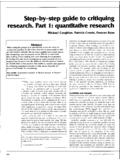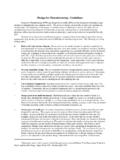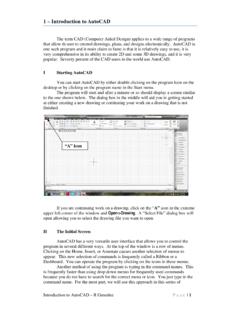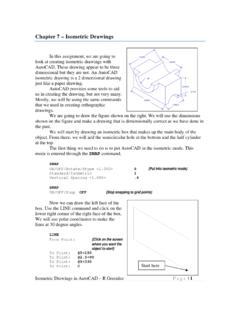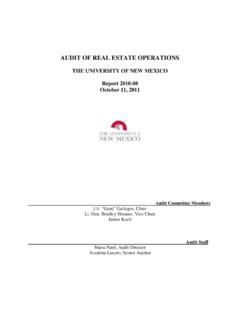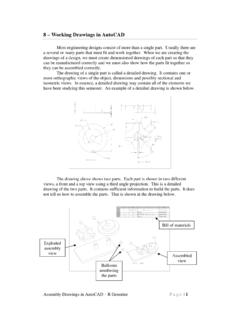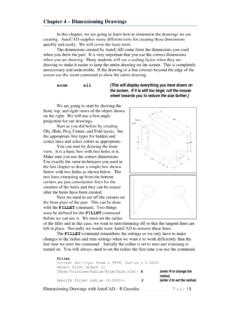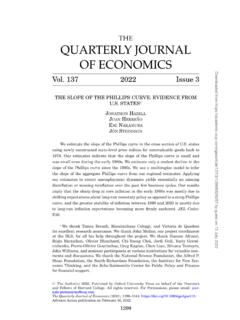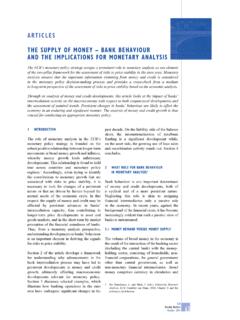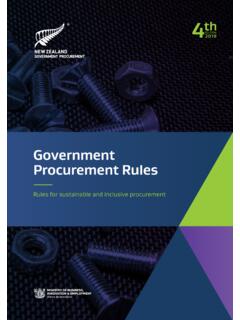Transcription of 303 Sample Questions #3
1 Page 1 Econ 303: Intermediate Macroeconomics I Dr. Sauer Sample Questions for Exam #3 1. When firms experience unplanned inventory accumulation, they typically: A) build new plants. B) lay off workers and reduce production. C) hire more workers and increase production. D) call for more government spending. 2. After the Kennedy tax cut in 1964, real GDP: A) fell and unemployment rose. B) rose and unemployment fell. C) and unemployment both rose. D) and unemployment both fell. 3. The theory of liquidity preference implies that: A) as the interest rate rises, the demand for real balances will fall. B) as the interest rate rises, the demand for real balances will rise. C) the interest rate will have no effect on the demand for real balances. D) as the interest rate rises, income will rise.
2 4. When drawn on a graph with Y along the horizontal axis and E along the vertical axis, the line showing planned expenditures rises to the: A) right with a slope less than one. B) right with a slope greater than one. C) left with a slope less than one. D) left with a slope greater than one. 5. An increase in taxes shifts the IS curve, drawn with income along the horizontal axis and the interest rate along the vertical axis: A) downward and to the left. B) upward and to the right. C) upward and to the left. D) downward and to the right. 6. The theory of liquidity preference implies that the quantity of real money balances demanded is: A) negatively related to both the interest rate and income. B) positively related to both the interest rate and income. C) positively related to the interest rate and negatively related to income.
3 D) negatively related to the interest rate and positively related to income. 7. When Paul Volcker tightened the money supply: A) the inflation rate immediately fell. B) nominal interest rates fell in the short run. C) nominal interest rates fell in the long run. D) real balances rose in the short run. 8. When planned expenditure is drawn on a graph as a function of income, the slope of the line is: A) zero. B) between zero and one. C) one. D) greater than one. Page 2 9. An increase in government spending generally shifts the IS curve, drawn with income along the horizontal axis and the interest rate along the vertical axis: A) downward and to the left. B) upward and to the right. C) upward and to the left. D) downward and to the right. 10. According to the analysis underlying the Keynesian cross, when planned expenditure exceeds income: A) income falls.
4 B) planned expenditure falls. C) unplanned inventory investment is negative. D) prices rise. 11. In the Keynesian-cross model, as the interest rate increases, the equilibrium level of income _____, whereas in the loanable funds model, as the level of income increases, the equilibrium level of the interest rate _____. A) increases; increases B) increases; decreases C) decreases; decreases D) decreases; increases 12. Along an IS curve all of the following are always true except: A) planned expenditures equal actual expenditures. B) planned expenditures equal income. C) the demand for real balances equals the supply of real balances. D) demand and supply of loanable funds are equal. 13. According to the theory of liquidity preference, a decrease in income will _____ interest rates, and according to the quantity equation (assuming velocity is not constant), a decrease in interest rates will _____ income.
5 A) increase; increase B) increase; decrease C) decrease; decrease D) decrease; increase 14. a. Graphically illustrate the impact of an open-market purchase by the Federal Reserve on the equilibrium interest rate using the theory of liquidity preference and the market for real money balances. Be sure to label: i. the axes; ii. the curves; iii. the initial equilibrium values; iv. the direction the curve shifts; and v. the terminal equilibrium values. b. Explain in words what happens to equilibrium interest rate as a result of the open-market purchase. 15. When drawn on a graph with income along the horizontal axis and the interest rate along the vertical axis, the IS curve generally: A) is vertical. B) is horizontal. C) slopes upward and to the right. D) slopes downward and to the right. 16.
6 In the IS-LM model, a decrease in expected inflation (an increase in expected deflation), leads to a(n): A) increase in both output and the nominal interest rate. B) decrease in both output and the nominal interest rate. C) increase in output and a decrease in the nominal interest rate. D) decrease in output and an increase in the nominal interest rate. Page 3 17. If neither investment nor consumption depends on the interest rate, then the IS curve is _____ and _____ policy has no effect on output. A) vertical; monetary B) horizontal; monetary C) vertical; fiscal D) horizontal; fiscal 18. An increase in investment demand for any given level of income and interest rates--due, for example, to more optimistic animal spirits --will, within the IS-LM framework, _____ output and _____ interest rates.
7 A) increase; lower B) increase; raise C) lower; lower D) lower; raise 19. An economic change that does not shift the aggregate demand curve is a change in: A) the money supply. B) the investment function. C) the price level. D) taxes. 20. The spending hypothesis suggests that the Great Depression was caused by a: A) leftward shift in the IS curve. B) rightward shift in the IS curve. C) leftward shift in the LM curve. D) rightward shift in the LM curve. 21. Assume that an economy is described by the IS curve Y = 3,600 + 3G - 2T - 150r and the LM curve Y = 2 M/P + 100r [or r = - (M/P)]. The investment function for this economy is 1,000 - 50r. The consumption function is C = 200 + (2/3)(Y - T). Long-run equilibrium output for this economy is 4,000. The price level is and M = 1,200.
8 A. Assume that government spending is fixed at 1,200. The government wants to achieve a level of investment equal to 900 and also achieve Y = 4,000. What level of r is needed for I = 900? What levels of T and M must be set to achieve the two goals? What will be the levels of private saving, public saving, and national saving? (Hint: Check C + I + G = Y.) b. Now assume that the government wants to cut taxes to 1,000. With G set at 1,200, what will the interest rate be at Y = 4,000? What must be the value of M? What will I be? What will be the levels of private, public, and national saving? (Hint: Check C + I + G = Y.) c. Which set of policies may be referred to as tight fiscal, loose money? Which set of policies may be referred to as loose fiscal, tight money? Which policy mix most encourages investment? 22.
9 If consumption is given by C = 200 + (Y - T) and investment is given by I = 200 - 25r, then the formula for the IS curve in a closed economy is: A) Y = 400 - - 25r + G. B) Y = 1,600 - 3T - 100r + 4G. C) Y = 400 + - 25r - G. D) Y = 1,600 + 3T - 100r - 4G. 23. Other things equal, a given change in money supply has a larger effect on demand the: A) flatter the IS curve. B) steeper the IS curve. C) smaller the interest sensitivity of expenditure demand. D) smaller the income sensitivity of expenditure demand. Page 4 24. Suppose Congress wishes to reduce the budget deficit by reducing government spending. Use the IS-LM model to illustrate graphically the impact of the reduction in government spending on output and interest rates. Be sure to label: i. the axes; ii. the curves; iii. the initial equilibrium values; iv.
10 The direction the curves shift; and v. the terminal equilibrium values. 25. The monetary transmission mechanism in the IS-LM model is a process whereby an increase in the money supply increases the demand for goods and services: A) directly. B) by lowering the interest rate so that investment spending increases. C) by raising the interest rate so that investment spending increases. D) by increasing government spending on goods and services. 26. One policy response to the economic slowdown of 2001 was a tax cut. This policy response can be represented in the IS-LM model by shifting the _____ curve to the _____. A) LM; right B) LM; left C) IS; right D) IS; left 27. A given increase in taxes shifts the IS curve more to the left the: A) larger the marginal propensity to consume. B) smaller the marginal propensity to consume.

